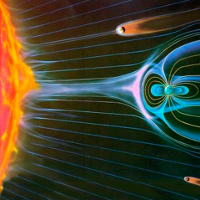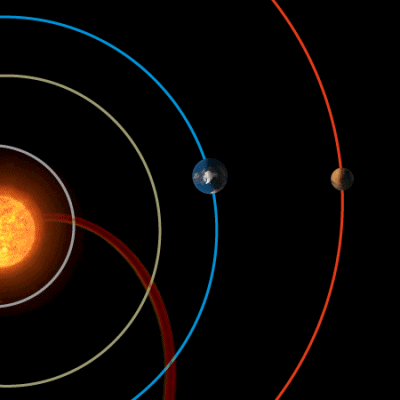Earth's protective bubble hasn't burst
7 March 2012
For the first time, the loss of atmospheric ions from Earth and Mars has been observed during the same solar wind stream. In a new study, data from ESA's Cluster and Mars Express spacecraft, which orbit the Earth and Mars respectively, have been used to compare the outflow of oxygen ions when the planets were aligned. The study's findings reaffirm the importance of the Earth's magnetic field in protecting our atmosphere from the solar wind, which had been questioned in recent years.Venus, Earth and Mars formed from the same material, but they have evolved in different ways so that they now look more like distant relations than siblings. While the atmosphere on Venus is much denser than on Earth, hiding the planet's surface from view at visible wavelengths, Mars only has a tenuous atmosphere.
 |
|
Artist's impression of the solar wind shaping the magnetospheres of Venus, Earth and Mars. |
Their differences can be partly explained by their varying distances from the Sun, with Venus' closer proximity causing a runaway greenhouse effect. For many years, scientists had also assumed that the Earth's magnetic field plays a crucial role in protecting atmospheric particles from being swept away by the solar wind. Mars, on the other hand, is at the mercy of the solar wind because its dynamo stopped working about four billion years ago.
"The shielding effect of the magnetic field is easy to understand and to prove in computer simulations, thus it has become the default explanation," says Yong Wei from the Max-Planck-Institut für Sonnensystemforschung, Germany.
In the past couple of years, though, some scientists have begun to question whether this easy explanation is the right one, as estimates of the escape rate of oxygen ions (O+) on Earth, Mars and Venus were found to lie in the same range. However, such comparisons were far from conclusive, as they were made under different solar conditions. "All of the estimated O+ escape rates on the planets varied by two orders of magnitude, depending on many factors, such as the solar wind dynamic pressure and the level of extreme ultraviolet radiation," comments Wei.
Now, in a new study led by Wei, scientists have compared observations of the O+ outflow from the Earth and Mars using data collected in January 2008 under similar solar conditions by ESA's Cluster and Mars Express spacecraft. To further enhance the test-like conditions, the observations were made when the planets were aligned on the same side of the Sun, so that they were exposed to the same level of extreme ultraviolet radiation.
The scientists compared O+ outflow fluxes when the dynamic pressure of the solar wind had increased by a similar amount at both planets. This allowed them to directly evaluate the effectiveness of the Earth's magnetic field in protecting our atmosphere. They found that when the solar wind dynamic pressure increased by 2-3 nPa – about twice and four times the average values at Earth and Mars, respectively – the rate of increase in Martian O+ outflow flux was one order of magnitude higher than Earth's. Such a difference in O+ losses would have a dramatic impact over a timescale of billions of years.
Next, taking full advantage of the alignment of Earth and Mars, the scientists looked at the role that orbital radius plays in atmospheric evolution. To do this, a ‘marker' was needed to pinpoint the same region in the solar wind as it propagated from Earth to Mars. This position marker came in the form of a corotating interaction region (CIR), which is a compression region between fast- and slow-moving solar wind streams.
 |
|
Propagation of a corotating interaction region (CIR) from Earth to Mars. Credit: ESA |
By comparing observations made by Cluster and Mars Express, the scientists found that the rate of increase in O+ losses was the same order of magnitude on both planets under these different conditions. Since the scientists have already shown the protective role of Earth's magnetic field, they propose that the similar rate of increase is attributed to Mars' greater distance from the Sun. This is the first observational evidence that distance plays an important role in the evolution of planetary atmospheres.
The team now plans to incorporate data from ESA's Venus Express spacecraft into their work. "Like Mars, Venus has no global magnetic field, but it is similar in size to Earth. It is therefore important in helping us to understand the role of Earth's magnetosphere," says Markus Fraenz from the Max-Planck-Institut für Sonnensystemforschung, Germany, who is one of the co-authors of the study.
Several upcoming planetary alignments will provide more opportunities for cooperation between missions. "For the next few months there is a good alignment between the Sun, Earth and Mars, and observations made by many spacecraft, including Mars Express and NASA's solar observatory STEREO, will be analysed together," says Olivier Witasse, Mars Express Project Scientist.
Cluster will also play an important role in these studies, as it is the only mission in near-Earth space capable of making such measurements. In addition, scientists are keen to observe how the increase in solar activity associated with the approaching maximum in the current solar cycle may affect the loss of atmospheric ions. "The European family of Solar System missions, with their unique observational capabilities, will play a vital role in studying this behaviour during the approaching maximum in solar activity," concludes Matt Taylor, Cluster Project Scientist.
Notes for editors
The study presented here is based on measurements of oxygen ion outflow obtained with the Cluster Ion Spectrometer (CIS) and the Mars Express Analyzer of Space Plasma and Energetic Atoms (ASPERA) in January 2008. The propagation of a corotating interaction region (CIR) was recorded by NASA's STEREO and ACE spacecraft as well as by Cluster and Mars Express.
Cluster is a constellation of four spacecraft flying in formation around Earth. It is the first space mission able to study, in three dimensions, the natural physical processes occurring within and in the near vicinity of the Earth's magnetosphere. Launched in 2000, it is composed of four identical spacecraft orbiting the Earth in a pyramidal configuration, along a nominal polar orbit of 4 × 19.6 Earth radii (1 Earth radius = 6380 km). Cluster's payload consists of state-of-the-art plasma instrumentation to measure electric and magnetic fields over a wide frequency range, and key physical parameters characterizing electrons and ions from energies of nearly 0 eV to a few MeV. The science operations are coordinated by the Joint Science Operations Centre (JSOC), at the Rutherford Appleton Laboratory, United Kingdom, and implemented by ESA's European Space Operations Centre (ESOC), in Darmstadt, Germany.
Mars Express, launched in June 2003, represents ESA's first visit to another planet in the Solar System. The scientific payload, provided by research institutes throughout Europe, consists of seven instruments that provide remote sensing measurements of the atmosphere, ground and below the surface. Since arrival in orbit around Mars in December 2003, Mars Express has been helping to answer fundamental questions about the geology, atmosphere, surface environment, history of water and potential for life on Mars.
Reference publication
Wei, Y., et al. (2012), Enhanced atmospheric oxygen outflow on Earth and Mars driven by a corotating interaction region, J. Geophys. Res., 117, A03208, doi:10.1029/2011JA017340
Contacts
Yong Wei
Max-Planck-Institut für Sonnensystemforschung,
Germany
Email: wei mps.mpg.de
mps.mpg.de
Markus Fraenz
Max-Planck-Institut für Sonnensystemforschung,
Germany
Email: fraenz mps.mpg.de
mps.mpg.de
Phone: +49 5556 979 441
Olivier Witasse, Mars Express Project Scientist
Research and Scientific Support Department
Directorate of Science & Robotic Exploration
ESA, The Netherlands
Email: Olivier.Witasse esa.int
esa.int
Phone: +31 71 5658015
Matt Taylor, Cluster Project Scientist
Research and Scientific Support Department
Directorate of Science & Robotic Exploration
ESA, The Netherlands
Email: mtaylor rssd.esa.int
rssd.esa.int
Phone: +31 71 5658009

